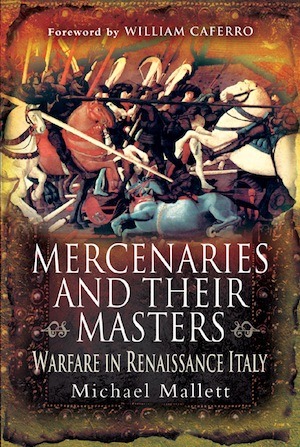
Michael Mallett
Mercenaries and their Masters. Warfare in Renaissance Italy
Barnsley: Pen & Sword Military, 2009. ISBN 978 184884 031 7, list price £19.99.
Until recently, Mercenaries and their Masters was perhaps the most useful and important book on medieval warfare that was not available in print. Fortunately Pen and Sword have now re-issued the work in a well-produced and reasonably priced new edition, with a foreword by William Caferro.
Despite the thirty-five years since its original publication, Mallett’s book remains unequalled as an overview of Italian warfare in the Late Middle Ages. It is true that a substantial amount of scholarly work has since been done on various aspects of the field—notably including books on the Sienese military experience and on the mercenary captain Sir John Hawkwood by Caferro, who was a student of Mallett’s. Nonetheless, the military history of medieval Italy remains a rather badly underdeveloped in comparison to the historiography available for France, Britain, the Low Countries or Spain. Much of the new work is in Italian, but even in that language there is no synthesis to rival Mallett’s.
In addition to providing a rich store of information and concise analysis regarding a whole range of topics—from synopses of battles, campaigns, and the careers of prominent military leaders, to explanations of military structures and institutions, to conditions of life and military service for common soldiers—Mercenaries and their Masters is a model for how to write “war and society” history. The author moves far beyond campaign narrative style of Sir Charles Oman, but unlike some other historians of the genre he never loses track of the key point that armies were raised, equipped, and sent into action for the purpose of fighting and winning wars.
The book takes the form of a broad survey—one which unfortunately lacks a full scholarly apparatus criticus—though the by-chapter bibliographical notes supply some of the same information that footnotes or endnotes would provide. They show that in addition to scholarly works in various languages and published documents and narrative sources, the author made substantial work of unpublished archival material. By way of background to the meat of the book, thirteenth-century warfare is covered in a single chapter before Mallett delves into fourteenth and fifteenth century warfare. The fifteenth century is treated more fully than the fourteenth, with a particular stress on the period 1420-1450.
One of Mallett’s main arguments is that historians have tended to be misled into underestimating the efficiency of Italian military institutions of the fifteenth century by the testimony of early sixteenth-century commentators, and that they have overstated the differences between Italian and trans-Alpine developments in warfare in the period leading up to Charles VIII’s stunningly successful invasion of Italy in 1494. Machiavelli was particularly influential in this way. Mallett’s case is generally well-made, though his revisionism may have gone too far in places. For example, his assertion (p. 4) that “all armies of the period were... mercenary armies in the widest sense of the word” may be true, if the widest sense of “mercenary” is equal to “paid,” but that is certainly not the normal meaning of the word, and the claim does not give due weight to the real and significant differences between an army of compagnies d’ordonnance and one composed of companies of condottieri—even ones led by the more aristocratic, professional, and stable condottieri of the fifteenth century, whose difference from their more freebooting fourteenth-century predecessors Mallett emphasizes.
In sum, Mercenaries and their Masters is a classic of medieval military history, which belongs on the shelf of every scholar of the subject, and certainly in every university library.
